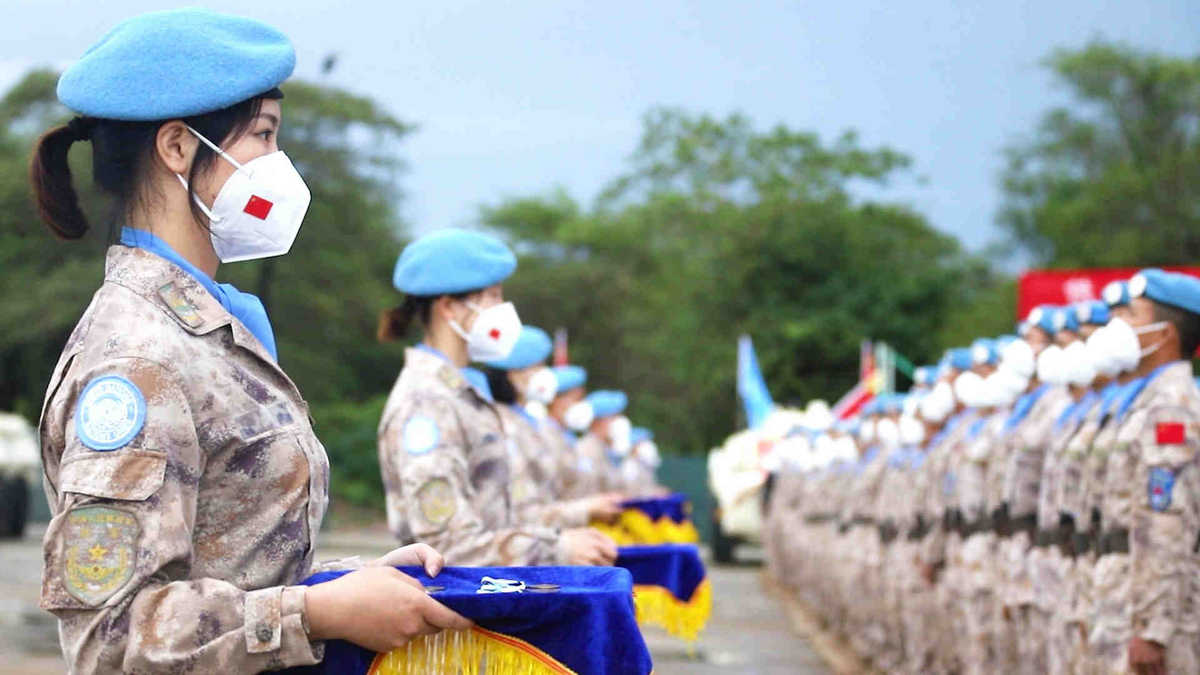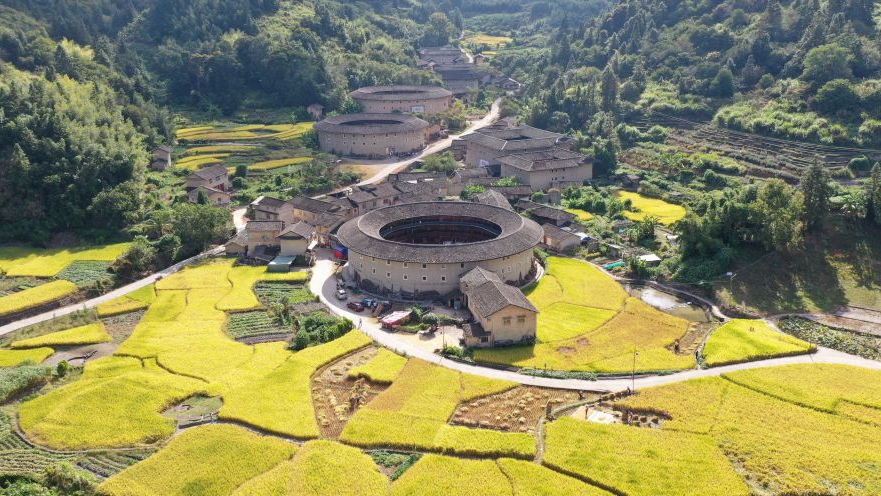PLA remains powerful force for world peace

Members of the eighth Chinese peacekeeping infantry battalion sent to South Sudan attend a medal ceremony of the United Nations Mission in South Sudan in Juba on Sept 30. SUN XUESONG/XINHUA
Military boosts building of community with a shared future for mankind
Editor's note: To mark the 95th anniversary of the founding of the People's Liberation Army, China Daily is publishing a series of stories elaborating on Xi Jinping Thought on Strengthening the Military, expounding its main ideas from different angles.
The PLA is a well-known abbreviation, standing for the People's Liberation Army, the Chinese military. It also stands for another characteristic of the armed forces: a "peace-loving army".
The unique expression was featured in a bilingual promotional video recalling the military's 32-year peacekeeping history and received millions of thumbs-up on Chinese social media on Sept 3, the day that marked the 77th anniversary of the victory of the Chinese People's War of Resistance against Japanese Aggression (1931-45) and the World Anti-Fascist War.
The broad appreciation for the video shows that the pursuit of peace is ingrained in the nation and that the Chinese people care about the well-being of humanity. President Xi Jinping, who is also general secretary of the Communist Party of China Central Committee and chairman of the Central Military Commission, said that the Chinese army will always be a staunch force in efforts to maintain world peace.
Experts and front-line peacekeepers have echoed Xi, saying that the Chinese military, which firmly pursues a national defense policy that is defensive in nature, has always stood for peace and justice, a belief that has been supported by concrete actions.
As China honors its responsibilities as a major country, its armed forces will actively promote the building of a community with a shared future for mankind, fulfill its international obligations and strive for a better world with lasting peace and common security, they said.
Such missions are outlined in Xi Jinping Thought on Strengthening the Military, which espouses the latest development of the Party's military philosophy and explores what kind of armed forces should be developed to better respond to the realities of the new era and what steps should be taken to build such forces.
The Thought has also provided a fundamental guideline for China's national defense policy that is defensive in nature.
Under the guidance of the Thought, China's national defense in the new era aims at resolutely safeguarding the country's sovereignty, security and development interests while never seeking hegemony, expansion or building spheres of influence, according to the white paper "China's National Defense in the New Era".
To welcome the upcoming 20th National Congress of the CPC, a book chronicling the building of a strong military and national defense in the past decade was published on Sunday, recording achievements in strengthening the military under the leadership of the CPC in the new era.
Commitment to peace
In 1990, China embarked on its new voyage as a participant in United Nations peacekeeping operations by sending five military observers to join the UN Truce Supervision Organization.
So far, it has sent nearly 50,000 peacekeepers to aid 25 UN peacekeeping missions, and it has become the second-largest contributor to the UN peacekeeping budget and the top contributor of peacekeepers among the five permanent members of the UN Security Council, according to the Ministry of National Defense.
Zhou Bo, a senior fellow at Tsinghua University's Center for International Security and Strategy, said that the UN's primary task is to maintain world peace, stressing that China has a unique advantage as a participant in the peacekeeping operations.
Such participation "combines high-quality equipment, disciplined personnel and a strong political will to maintain peace", said Zhou, who was also the former director of the Center for Security Cooperation at the Office for International Military Cooperation of the Central Military Commission. "These three elements only occur together in the Chinese military."
At the UN peacekeeping summit in 2015, Xi announced six measures that China would take to support these operations. All six measures have been fully implemented, including establishing a peacekeeping standby force of 8,000 troops, offering 20 training programs to over 1,500 peacekeepers from more than 60 countries, and sending 25 rotations of engineer and medical units totaling 7,001 troops to missions in Africa and Asia.
The PLA has become a key force in UN peacekeeping operations and can "send more types of peacekeeping troops in larger numbers to participate in peacekeeping operations at any time" depending on the needs of the operations, said Cai Hui, a senior peacekeeping instructor and an associate professor for military diplomacy and international cooperation at the PLA National University of Defense Technology.
Ke Changshui was among the 700 troops in the infantry battalion sent to the UN Mission in South Sudan in 2015, China's first organic unit of its kind to take part in a peacekeeping mission. Ke said that as the military of a responsible world power, the PLA has made an outstanding contribution to efforts to uphold world peace.
The missions have cost some soldiers their lives. Since 1990, 16 Chinese peacekeepers have died while serving overseas, and their bodies will never be returned, according to the white paper "China's Armed Forces: 30 Years of UN Peacekeeping Operations", which was released in 2020.
Peacekeeping efforts
In addition to participating in the UN peacekeeping operations, the PLA helps maintain world peace in other ways, including sending naval forces to foil pirates aiming to raid ships, actively taking part in global rescue efforts and offering humanitarian aid, Cai said.
"Since 2012, the Chinese military has launched or participated in several disaster relief efforts and emergency response operations, including rescue work in the Philippines after the nation was hit hard by Super Typhoon Haiyan in 2013, the search for the missing MH370 flight in 2014 and the fight against the Ebola epidemic in West Africa," he said, stressing that the PLA has also provided medical aid to numerous countries and armies since the start of the COVID-19 pandemic.
Furthermore, the Chinese naval hospital ship Peace Ark has visited 43 countries and regions around the globe and provided medical services to more than 230,000 people since it entered service in 2008.
"We have cared for life, sown the seeds of friendship throughout the world and maintained world peace by healing the wounded and rescuing the dying, which is humanitarian," said Deng Qiang, captain of the Peace Ark, adding that the ship has been conveying the PLA's peace-loving message to the world.
Over the past 32 years, Chinese peacekeepers have left their footprints in over 20 countries and regions across Africa, Asia and Europe, including Cambodia, Lebanon, Cyprus, South Sudan and Mali. Currently, more than 2,200 Chinese peacekeepers are on duty at the UN Headquarters in New York and in seven peacekeeping missions worldwide, according to the Defense Ministry.
Photos
Related Stories
- Naval frigate flotilla conducts all-subject training assessment
- ‘Never-seen-before equipment’ from PLA to appear at Airshow China 2022: senior colonel
- PLA Air Force unveils armed reconnaissance drone unit in NW China
- Army aviation helicopters engage in flight training
- Chinese naval vessels conduct live-fire drills during Vostok-2022
Copyright © 2022 People's Daily Online. All Rights Reserved.









